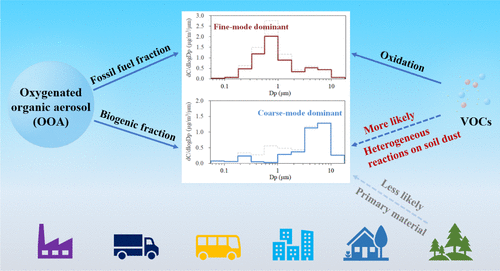当前位置:
X-MOL 学术
›
Environ. Sci. Technol.
›
论文详情
Our official English website, www.x-mol.net, welcomes your
feedback! (Note: you will need to create a separate account there.)
Abundant Biogenic Oxygenated Organic Aerosol in Atmospheric Coarse Particles: Plausible Sources and Atmospheric Implications.
Environmental Science & Technology ( IF 10.8 ) Pub Date : 2019-12-31 , DOI: 10.1021/acs.est.9b06311 Xiao-Feng Huang 1 , Jing Dai 1 , Qiao Zhu 1 , Kuangyou Yu 2 , Ke Du 2
Environmental Science & Technology ( IF 10.8 ) Pub Date : 2019-12-31 , DOI: 10.1021/acs.est.9b06311 Xiao-Feng Huang 1 , Jing Dai 1 , Qiao Zhu 1 , Kuangyou Yu 2 , Ke Du 2
Affiliation

|
Secondary organic aerosol (SOA) is a key component in atmospheric aerosols, strongly influencing air quality and climate. Most previous studies focused on SOA formation in the fine aerosol mode, and little is known about SOA formation across a broader size range, especially for the coarse aerosol mode. In this study, we coupled radiocarbon analysis and the offline aerosol mass spectrometric method to characterize water-soluble organic matter in size-segregated samples between 0.056 and 18 μm collected in urban Shenzhen, China. For the first time, detailed size distributions of different types of oxygenated organic aerosols (OOAs) are obtained. Fossil fuel OOA was mostly distributed in fine particles, and biogenic OOA occurred mostly in coarse particles. Organic composition and correlation analyses suggested that the major source of the coarse-mode OOA was more plausible to be heterogeneous reactions of biogenic volatile organic compounds (VOCs) on soil dust rather than primary biological materials. If so, this mechanism would complement the missing sinks of biogenic VOCs, significantly influence the regional and global organic aerosol budgets, and thus should be considered in air quality and climate models. This study highlights the urgent need for laboratory simulations of heterogeneous reactions of various VOCs on soil dust.
更新日期:2020-01-14











































 京公网安备 11010802027423号
京公网安备 11010802027423号